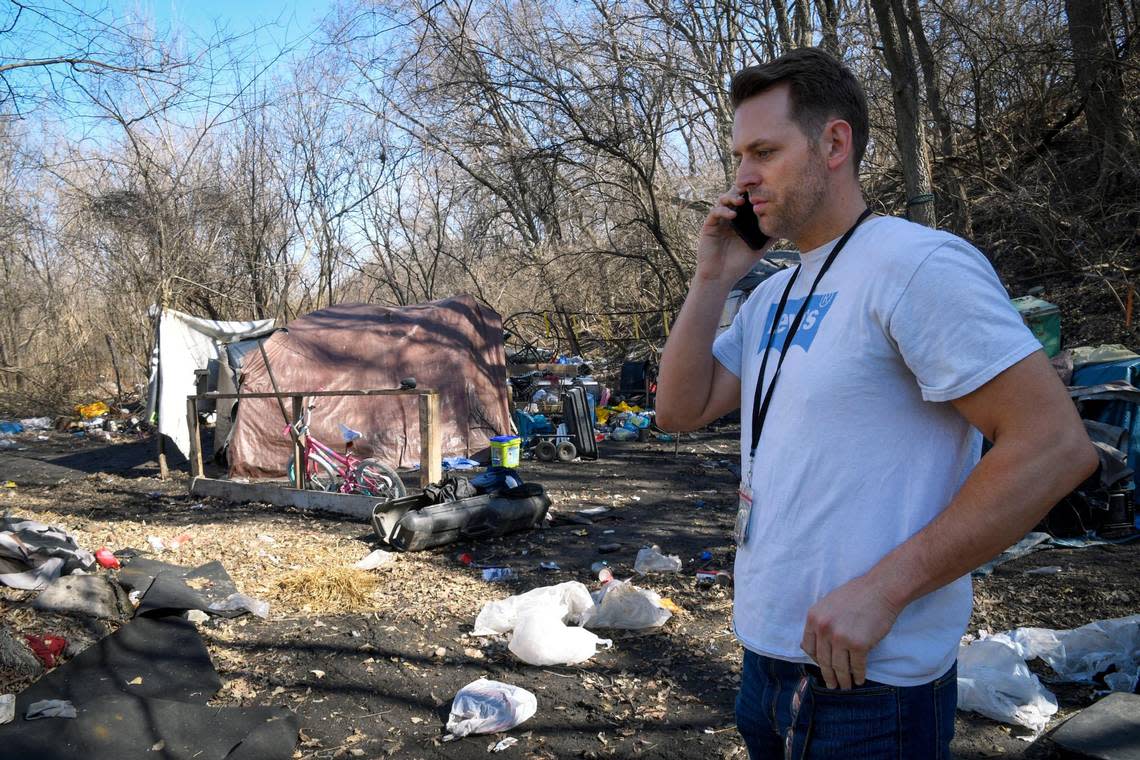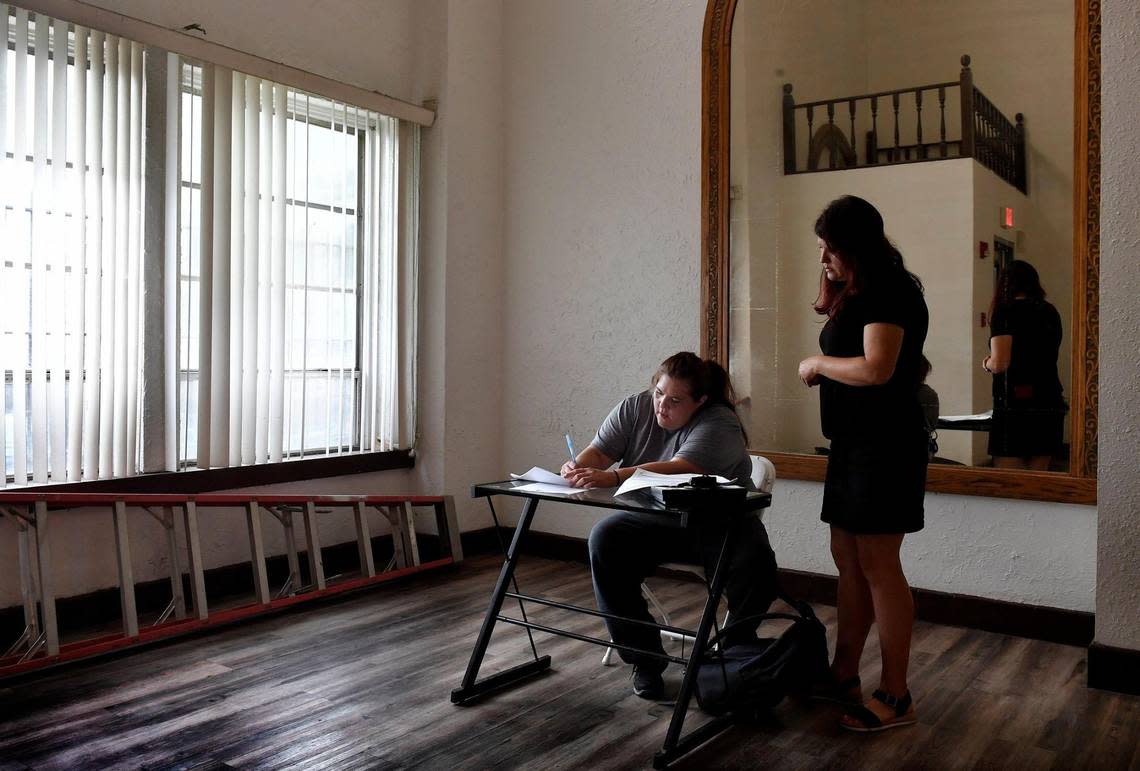Kansas City homeless shelters are full. Moms, kids, elderly among those on streets
Every morning at 9 a.m., Kesha calls about 20 homeless shelters in the Kansas City metro, hoping someone has room for her and her children. Then she calls again at 3 p.m.
She’s completed this ritual for the past month from the hotel room where she’s staying with her three sons, ages 6, 7 and 8. But each call ends the same way, she said: no one has room.
The 30-year-old single mother, who asked to go only by her first name to maintain privacy, is among a growing number of people who in recent months have struggled to get the immediate help they need. They quickly learned, as advocates and some within the city already know, that Kansas City shelters are full.
As the number of people experiencing homelessness in Kansas City and around the country rose in recent years — in part a result of the financial hardships exacerbated by the pandemic — those who work to end homelessness locally say not enough has been done to expand emergency shelter opportunities.
“There are no spots for children, women and children, single women, people with disabilities or our elderly,” said Jennifer Hull, who has worked in Kansas City as a contractor and volunteer street outreach worker for the past few years.
While there are shelters in Kansas City, they are not accessible to everyone. Emergency low-barrier shelters would remove many of the requirements and prerequisites that current shelters have in place for entry.
As of noon Thursday, no shelter bed availability existed for families, transitional youth, unaccompanied youth, domestic violence survivors or single females, according to the city’s dashboard. Just shy of 100 beds were available for single men, all through City Union Mission.
Five years ago, when Kesha first experienced homelessness in Kansas City, she said it was much easier to find a shelter bed to sleep in at night.
“But now it’s like it’s really bad and just shows me that I’m not the only person who is going through this,” she said.
Families, elderly turned away
The need is unlike anything Hull has seen before. The traffic of people in and out of shelters is at a standstill, she said.
The street outreach worker spent the weekend of Juneteenth juggling phone calls and hospital visits, trying to get people to safe places. Hull said shelters that she previously relied on for emergency placement now have three week waits.
No one, for example, could accommodate the single mother and her three children under the age of five who Hull was trying to help that weekend.
Nor could they help the couple with a 9-month-old baby who, because of the lack of shelter opportunities, instead camped out at a bus stop. Hull said. They spent so much time there that the child had to be taken to an emergency room for severe sunburns.
And then there was the elderly woman with severe back injuries who, after not being able to get a shelter bed, twice suffered heat exhaustion. The second time she became ill, Hull was there to take her to the ER. After the woman received a few IV bags and a nap in a hospital bed, Hull dropped her back off in the heat, at a homeless camp. She said she had no other options.
“I am devastated on the daily by what I encounter on the streets of this city. It has been over six months since I’ve been able to secure a place for families with very young children in an NGO (non-governmental organization) shelter placement,” she told city council members last week as she called for creating more shelters.
Lives are at stake, she said.
“It should not be this difficult. We can not continue this way ....” she said. “We’ve been deadlocked for so long just talking in circles.”
Committee blocks latest resolution
Kansas City does not have emergency 24/7 shelters with few barriers to entry for those who need help, said Josh Henges, the city’s first homelessness prevention coordinator.
He too has noticed the increased visibility of people living on the streets. Local agencies estimate Kansas City has about 2,000 people experiencing homelessness and about 200 encampments spread across the area.
“When a system fails, people create their own, and a new shelter has become the encampments, and it’s not a safe place to be,” Henges told council members last week. “It’s not humane for folks to live there.”
The idea for pallet shelters, or tiny homes, as a form of emergency low-barrier shelter first came before the council last year, but has received push-back from community members reluctant to welcome a transient population to their backyard.
Because of this opposition, the pallet shelter proposals have stalled in City Hall. At this point, Henges said, any option is on the table, including renovating old hotels or city-owned properties.
A newer iteration of the pallet shelter resolution went before the city council’s Finance, Governance and Public Safety Committee last week. Had it passed, the city manager’s office would have been directed to devise a plan for any form of emergency housing within 14 days. Council members Katheryn Shields, Heather Hall and Lee Barnes voted no on the resolution, blocking it from advancing to the City Council for a vote.
Shields, who questioned the need for the resolution, said she preferred that a plan for emergency shelter be included in the full report on homelessness due in late August to the council from the city’s houseless task force, which was formed in early 2021 by Mayor Quinton Lucas.
Councilwoman Ryana Parks-Shaw, who voted yes, argued that the resolution would allow the city to specifically address the need for emergency low-barrier shelter months ahead of the full plan being ready in late August.
Lives are at risk, she told her colleagues just days before Kansas City entered another excessive heat warning.
“We need to either do this, or, for lack of more appropriate terms, get off the pot,” said Councilwoman Melissa Robinson, who introduced the resolution in February.
In a perfect world, emergency low-barrier shelters would have been in place “yesterday,” City Manager Brian Platt told The Star on Thursday.
“We’re in an urgent and critical scenario here where we really need more facilities, more beds and more ways to serve the community to get people off the street,” he said.
Last spring, the city secured a few hundred hotel rooms as emergency housing through the heat of the summer months. The quick-fix, while providing temporary safety from the sun, drew some criticism in its lack of coordination and wrap-around services.
Come this year, with no similar hotel fix in place, Platt said he’d hoped the city would be further along with creating a more permanent solution. Compared to last year, service providers are better-coordinated and, unlike last summer when many people stayed at encampments, nearly every available shelter bed is filled.
Henges, the city’s homelessness prevention coordinator, said Thursday that he’s looking at two options going forward: either existing shelters lower their barrier to entry to accommodate more people, or the city forges ahead to build a low-barrier shelter itself.

Marqueia Watson, executive director at the Greater Kansas City Coalition to End Homelessness, said she was “dumbfounded” by the committee’s vote on June 29.
While permanent housing remains the ultimate goal, emergency shelter is a necessary first step, she said. And the committee’s vote slowed that next step.
Many shelters don’t have the staff, capacity or resources to accommodate the community’s growing needs, she said. It can be particularly difficult for the gravely ill, women and trans women to secure a bed, she said.
In addition to providing safety, an emergency shelter could also help connect people with resources that help them find stability long-term, known as the continuum of care, which includes securing housing vouchers, vital documents and medical help.
There is money to do it, thanks to COVID relief funds, Watson said. What’s lacking is movement at City Hall.
‘Mommy, are we gonna get a home?’
On Thursday morning, Hull drove one of her clients, Christina Smith, from apartment to apartment, helping her fill out applications for housing.
Smith, 33, became homeless again in May after her mother, who she’d been living with, started experiencing health problems and Smith needed to move out. She took her son, now 13, and pitched a tent at an encampment in northeast Kansas City.
Hull met Smith and her son about a month later. Concerned that a child was sleeping in the woods, Hull helped the small family secure funding for a month-long hotel stay. But on Monday, that funding runs out.
When Smith realized she needed her son’s social security card, which was sitting in an impounded car across the city, as part of the apartment application, Hull gently walked her through next steps.
“I’m homeless,” Smith said as she passed the thick application packet and dusty clipboard back to the apartment employees.
She would soon be on the streets again if she couldn’t secure housing. Was there any chance they could get her a unit by Monday?
Monday was too soon, they said. But, at the prompting of Hull, they agreed to attach a note to Smith’s application conveying the urgency of her situation.
Smith doesn’t want to go back to the encampment. It was no place for a child, she said. If they existed, emergency low-barrier shelters would have been a better option.

At the same time, the clock continued ticking for Kesha, the mother of three, who also faces a Monday hotel deadline.
In November, Kesha came down with COVID-19. Without paid sick leave, she soon lost her job as a cook at a Johnson County senior home. Like clockwork, she fell behind on her rent and was evicted from her apartment of nearly three years.
Kesha said she and her boys spent the first couple nights sleeping in her car. About a week later, a local nonprofit secured funding to put them up in a hotel for a month. Since then, she’s tried to no avail to secure childcare for her boys, who are out of school for the summer. Without childcare, she said, she can’t find a new job.
“Mommy, are we gonna get a home?” her boys ask.
“Yes baby, it’s not always going to be like this,” she tells them.
When she cries in front of them, they wipe her tears and ask if she’s OK. She lies and says yes.
“Physically and mentally I’m not OK,” she said, her voice breaking. “I’m really stressed out.”
